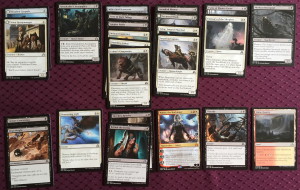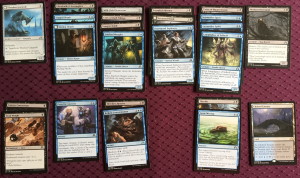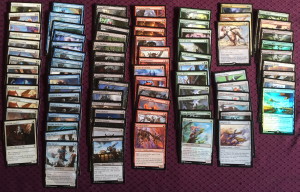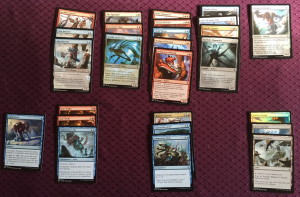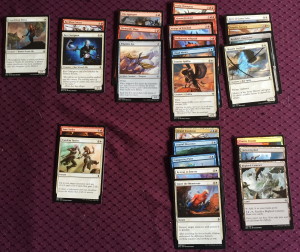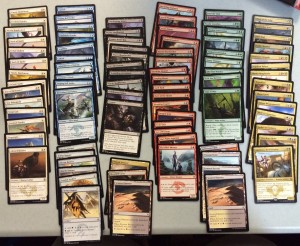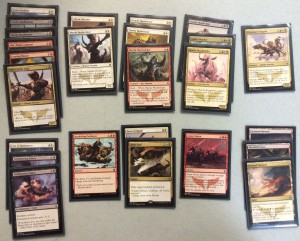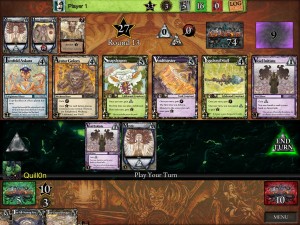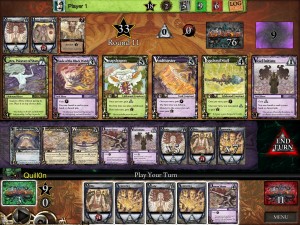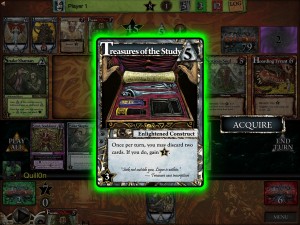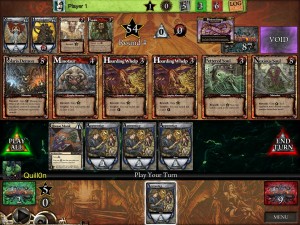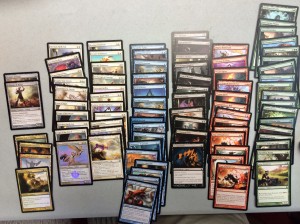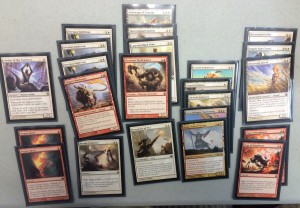Yesterday I headed down to Isle of Gamers for the prerelease for the latest Magic set, Shadows Over Innistrad. After listening to the set review on Limited Resources, and poking around on the net a bit, my feeling was that this would be a complicated set, and that assimilating all the information in the sealed deck prerelease would be pretty daunting, trying to figure out how best to fit together the various moving parts.
Once I opened my packs, I had this card pool:
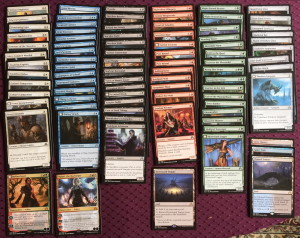
Notice the following things:
- I opened 7 rares (well, one was the promo card), of which 3 were land, 2 were planeswalkers (yay!), and 2 were not really great in limited.
- All five colors are somewhat playable – this is a pretty deep pool.
- Unfortunately, red is the weakest color, and green the second-weakest, and both planeswalkers require red.
- Black is both deep and has a bunch of removal, so I’m surely playing black.
My first inclination was to go white-black, splashing red for Nahiri, so I came up with this:
That’s not awful, but probably not worth splashing just for one card, even a really good one. And there isn’t really any other red worth splashing. The other thing I realized is that it often doesn’t start doing stuff until turn 3, and it doesn’t make great use of its rare, Odric.
So I decided to try again, with blue instead of white, which gives me a little more early options, and a little more flying power:
I would characterize this deck as “unexciting midrange” (no rares other than the dual land!), but I hoped it would make up for that in consistency and evasion, and after some agonizing, it’s the one I decided to go with. Here’s how it played out:
Round 1: I played against a white-blue deck, and both of our decks ended up playing out as control decks against the other. I had more evasion than he did, but he had cards like Puncturing Light and Sleep Paralysis to deal with my Stormrider Spirits. I won game 1 mainly on the back of Daring Sleuth‘s flip side giving me lots of card advantage, and he won game 2 by grinding me out. Then we drew game 3 because we didn’t have nearly enough time to finish.
After this round I decided that Wild-Field Scarecrow didn’t do much in this deck, so I replaced it with the more aggressive Wicker Witch, which turned out to be the right choice. I also swapped out Merciless Resolve for the cheaper Macabre Waltz, which also paid dividends as I often had creatures in my graveyard I wanted to get back.
Round 2: Another white deck, this time white-black. In game 1 I recognized that my draw was much more aggressive than his and won by pushing through damage early, combined with overwhelming board position through my incremental card advantage. Game 2 was a squeaker, with me seemingly taking a big advantage and playing the Morkrut Necropod, but he had an answer for it in Murderous Compulsion. He took me down to 1, and he was also at 1. I ended my turn with 3 creatures to his 2, and with Broken Concentration in hand I countered his attempt to cast Bygone Bishop (I believe my spoken response when he cast it was, “No no, no no no – no.”) and that was enough to push through the last point of damage on my next turn.
Round 3: My opponent ran me over in the first game, playing a white-green humans deck which fired on all cylinders. Game 2 went much better as he never drew green mana and so stalled out in the midgame. He later told me his deck was mostly white, so this was a weird draw for him. For my part I was pleased that I mulliganed a hand with 3 islands, 3 black spells, and an artifact creature. Game 3 was the opposite as he kept a hand with 3 forests, 3 white cards, and an Intrepid Provisioner. He didn’t draw a plains until it was too late, and I won again.
Afterwards we chatted about his last game’s keep, and I told him that I’d had a similar scenario in game 2, where I’d mulliganed, and that I always seemed to do (and feel) better when I mulliganed color-mismatch hands like that. He pointed out that he had many more plains in his deck than forests, and he only needed one to get going. I don’t know what the answer is; if he had 10 plains in his deck, then the odds were he’d draw one by turn 4, but he really needed to draw one before that if my deck curved out (which it did). So it was a tough loss for him.
Round 4: My opponent here unfortunately also had mana problems, stalling out at 3 land in game 1, and I had just the right removal for the cards she could play (such as the ultra-annoying Sin Prodder). In game 2 she got mana flooded, and while she did play a big bomb in Flameblade Angel when she was still around 14 life, Press For Answers was exactly the answer I needed to push through a bunch of damage which she didn’t have any other blockers for.
So in the end I went 3-0-1 in my 4 matches, which was good for fourth place overall (and 8 packs!) in a field of over 50 people. I feel that my deck overperformed a little bit, and that my opponents’ decks underperformed – in some cases by a lot – so I’m not sure whether I truly “earned” my record. But sometimes you end up on the good side of the variance gods.
A few lessons I learned from the day as regards the format:
- The removal doesn’t look impressive in this set, but a lot of it works well against a wide variety of threats. It seems like there are a lot of 2/3 and 3/2 creatures, and doing 2 damage does really well against the latter, while the former tend to be less threatening. As one person put it, there’s “not a lot of beef” in this set. (But – small sample size alert. There are a number of ways to make some larger creatures, and I just didn’t face many of them.)
- Morkrut Necropod is a better card than it looks like, as there are not many things which can deal with a 7/7 with Menace in the format, and sacrificing a land by the time it comes down is not a big penalty.
- It doesn’t take a lot of Investigate sources in your deck to enable cards which need them such as Daring Sleuth. I think I had 3 in my deck, and that was enough to pretty reliably flip the Sleuth.
- Also, Daring Sleuth can be a horse in limited.
- Gone Missing can do some work. One game when an opponent was struggling with mana, I put his tap-land on top of his deck, which not only blanked his next draw, but it meant even if he had anything to play with 4 mana that he hadn’t played for some reason (such as a combat trick), he would have to wait an extra turn to play it. Also great to enable an alpha strike.
- Accursed Witch is a great card. If they decide not to kill it, then it hits them for 4. If they do kill it, then (most of the time) it turns into an annoying enchantment.
- Thraben Gargoyle is also surprisingly good; by the time you can flip it, if your opponent hasn’t been careful to hold back some removal, a 4/2 flyer is pretty hard to deal with.
- Bygone Bishop looks awesome.
Also, having a deck where only one card costs double-colored-mana is a nice incremental advantage since it makes it harder to be color-screwed.
Also, it turns out that my worry about information overload was unfounded; while I could imagine that having several good Madness cards could lead to struggling to figure out how to use it effectively, I didn’t have that problem. And there are several good ways to interact with discarding and sacrificing and the graveyard which don’t require Madness.
This looks like it will be a fun format, though I think there will be more to keep track of in draft than in sealed (“Whoops I forgot to draft a discard outlet”), but it also looks possible to draft a pretty straightforward deck if you prefer. I also wonder if it’s going to be a less bomb-y format than most (i.e., a pauper rather than a prince format, as the lingo goes).
Obviously I have fun – winning is usually fun! Definitely more fun than the Battle for Zendikar prerelease last fall, where my pool was both not good, and not fun to play. And it was my best prerelease showing since Journey Into Nyx (which featured a fairly meat-and-potatoes aggro deck, albeit one with two great rares).
I’ve been averaging a little less than every other prerelease for the last few years, for a combination of reasons. I’m hoping I’ll be able to make it to the Eldritch Moon prerelease in late July.

